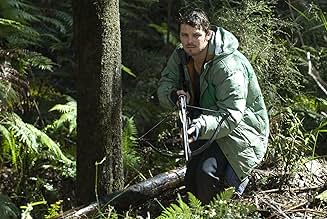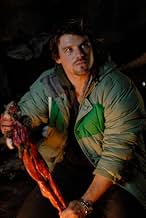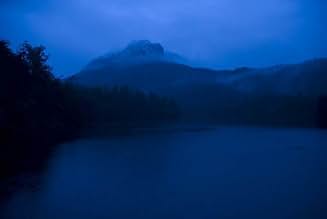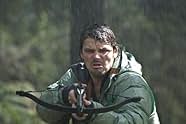Dying Breed interweaves the two most fascinating icons of Tasmanian history: the extinct Tasmanian tiger and "The Pieman" (aka Alexander Pearce) who was hanged for cannibalism in 1824. Again... Read allDying Breed interweaves the two most fascinating icons of Tasmanian history: the extinct Tasmanian tiger and "The Pieman" (aka Alexander Pearce) who was hanged for cannibalism in 1824. Against all odds, Pearce escaped from the most feared penal settlement of the British Empire - ... Read allDying Breed interweaves the two most fascinating icons of Tasmanian history: the extinct Tasmanian tiger and "The Pieman" (aka Alexander Pearce) who was hanged for cannibalism in 1824. Against all odds, Pearce escaped from the most feared penal settlement of the British Empire - Sarah Island - and disappeared into the impenetrable forests of Western Tasmania. Seven co... Read all
- Director
- Writers
- Stars
- Liam
- (as Ken Radley)
- Guard #2
- (as Paddy McIvor)
- Director
- Writers
- All cast & crew
- Production, box office & more at IMDbPro
Featured reviews
Four young cryptozoologists go to check out Western Tasmania in search of ye ol' Tasmanian Tiger. Little do they know they are stumbling upon the ancestors of Alexander Pearce, the famous Australian ex-convict, bush ranger and sometime cannibal known as the 'Pieman'. Suffice to say fine dining is loosed on the Pieman River as a group of Deliverance style in bred Tassie freaks hunt down our hapless Tiger hunters. Dying Breed is well cast with Leigh Whannell (Saw) giving us a great version of the metro-sexual out of his league in the wilds of Western Tasmania and Nathan Phillips (Wolf Creek) as a roustabout larrikin hunter. Whannel is an excellent leading man and should branch out from horror and do other serious work. The two girls Sally MacDonald and Melanie Vallejo are good too. Especially the later, when she is strung up and dismembered Cannibal Holocaust style out the back of the Pieman's shed. I'm sure Leigh Whannell must have been showing the director Cannibal Holocaust, as this scene certainly bears the imprint of that classic film and the Dying Breed scene is very well done in its brutality. The film has various very effective set pieces in a cave, at night in the bush, out the back of the killer's shed, on a bridge at dawn, etc. All shot effectively and scored very nicely. The ominous Tasmanian landscape evokes a darkness akin to what DH Lawrence said about the great primordial emptiness of the Australian bush. The film should travel well as the Aussie accents aren't too harsh, and one is a Irish accent. The family of inbred freaks are memorable and varied in their motivations and actions.
Dying Breed is a great edgy genre piece that is one of the first to appear in the new wave of horror cannibal films, so its ahead of the game world wide, also. I would have to rate it right up there with Rogue from last year and Acolytes, Horseman and Rats and Cats.
Why did they not enter it in MUFF? It would have won some awards! Check out the posters. I like the stylish one, while the second one with a gory pie will entice the teen market.
Stylish new Ozploitation is on display, that gives hope to the future of the Australian Film Industry!
Nothing new or different. Same old blood soaked chopping and slashing and women chasing.
Tired story line. Young people lost in woods find weirdos who eat people. Seen it before many times. BORING.
How to make a better movie. Drop the dumb dialogue, drop the dumb story line, get people who can act, they are called actors, less splash and more suspense, go back to telling an engaging story, and stop trying to be shocking. In fact, a good and well written movie would be shocking. Dying Breed sure was not anything worth seeing. The best part of dying breed were the few moments of the old (1930s) film clips of the Tasmaian Tiger
"Dying Breed" is another sub product of "The Texas Chainsaw Massacre" and gives the sensation of déjà vu to the viewer with the total lack of originality. There are many flaws in the predictable story, like for example, how could an expedition travel unarmed in a remote area in the wilderness? What would they expect while observing the wildlife? How can a group travel without a Plan B for unexpected situations? The greatest different in this feature is the wonderful location in Australia. Further, the acting is good and for fans of the slash genre, it entertains. My vote is six.
Title (Brazil): Not Available
It took at least 50 minutes for the main action to begin. The first act got repetitive, dull and boring quickly as our four main characters seemed to do nothing and just chat. Don't get me wrong, I love character development, but they could have taken about ten minutes off the first act. There were many pointless scenes.
The other bad factor was the acting. Leigh Whannel sadly gave a poor performance, as well as all the other members in the group of four.
Onto the good, the gore was excellent and the film had that raw and gritty feel to it. Some scenes were creepy and disturbing. Also, the ending was very good and a fitting climax to the film.
Overall, this is an above average Aussie horror with many flaws and clichés, but still manages to entertain. A very generous 7/10.
For me this film really came out of nowhere, as the striking poster artwork (featuring a half eaten pie with an eyeball and finger within it) caught my attention and some rave reviews can feed your appetite. Sadly though, I was only one of four who were at the cinema to see it. I probably could've gone without seeing it and waited for it to hit DVD, but there's nothing quite like watching a horror film on the big screen.
What this story sets off to be is a little unsure, but about midway through you know where it's heading (Psycho territory with cannibalistic currents). I might sound like a broken record, but really this isn't nothing new compared to much modern horror focusing on the visual torture and torment of its victims. While it might not be as abundant, it still lingers and has a really nasty side. It has explicitly raw moments with pockets of vicious intensity, but it was not the violence that unnerved but the ominously remote woodland backdrop with constant eerie imagery. The scenery is gorgeously lush, but lurking beneath the gracefully hypnotic setting is the true grotesque horror that's hidden very well. The nocturnal, but surprisingly also the day sequences can get under your skin. The cinematography is professionally catered for with it drawing upon the atmosphere and setting. Editing is brisk, but well infused.
As for the story it uses actual facts and spins them in to total fiction. The main base of the story centres on the history of the extinct Tasmanian tiger, which some still believe exists and combining that legend of the cannibalistic Irish convict Alexander Pearce that managed to escape from the penal colony and headed for the wilderness to only be hanged in 1824. Then we hit modern times with a group of four after the exclusive photograph of the Tiger, but one of girls lost her sister within the same area they're visiting in a supposed drowning many years earlier. Now cue those articles of missing backpackers. But when they meet the creepy locals, the inbred jokes flow. Still we're flooded with flashbacks, piled on to flashbacks. Even if the set-up is clichéd and obviously formulaic, these back stories do give it a little more background and depth, and lessens the idea of turning in to something meaningless. The script has its questionable actions, but mainly lets it go about things.
The pacing is rather leisured, and I can see many complaining about the slowness of the opening half (think of the criticism that 'Wolf Creek' copped). But I thought it was milked out accordingly and with a purpose, to hit you hard when it finally changed direction. Featuring heavily is that it centres on mood, visuals and sounds than that of tearing and ballistic actions. Even when it does break out from it's causal handling, it still doesn't burst out and only adds tension with jolts in scattered slabs and formulated rushes. When it comes to the end, I found it to be stumbling there and results not entirely satisfying. But it still keeps that glum feel throughout.
Jody Dwyer's assured direction is slick and stylish. Maybe too so, but it's a brash display as his not afraid to bare gore and flesh usually the latter in recent times sees little daylight in the mainstream horror releases. Even animal lovers should be aware. The performances are workmanlike, but no real empathic edge was created. Well not for me. One thing though it never seemed like they were ever aware in what type of situation they were or could be in, but when it unfolded it didn't entirely changed the perception. Leigh Whannel, Nathan Phillips, Mirrah Foulkes and Melanie Vallejo play the unlucky party.
A basic, but durably crafted genre effort.
Did you know
- TriviaDuring the first seconds of the end credits just 1 or 2 frames show what Pieman's Pie really is made of.
- GoofsWhile leaving the Water Rat Hotel at the start of the movie, a tram can be seen in the background and then disappears as the scene has been cut. Also this is supposed to be in Tasmania, they do not have Trams, this would of been filmed in Melbourne.
- ConnectionsFeatured in At the Movies: Episode #5.39 (2008)
Details
- Release date
- Country of origin
- Official site
- Language
- Also known as
- Chiếc bánh chết chóc
- Filming locations
- Production company
- See more company credits at IMDbPro
Box office
- Budget
- A$3,000,000 (estimated)
- Gross worldwide
- $370,294
- Runtime1 hour 32 minutes
- Color
- Sound mix
- Aspect ratio
- 1.85 : 1
Contribute to this page



























